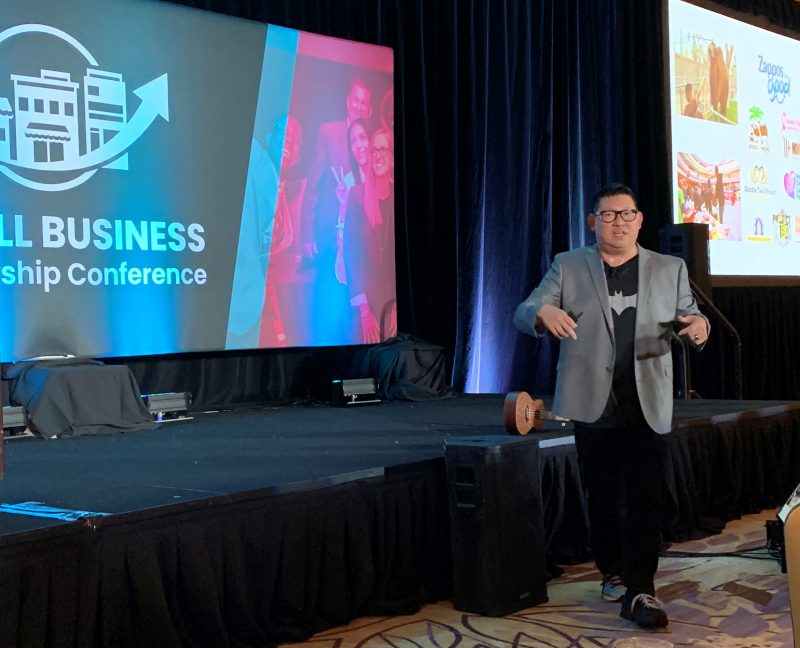Born in an era of e-commerce infancy, Zappos turned 20 this year.
“People thought we could never sell shoes online. We proved them wrong. And people said it’s crazy to think customer service could be a brand. We proved them wrong on that aspect as well,” says Ryo Hanalei Zsun, Zappos’ “Culture Maestro,” who was a keynote speaker at the Small Business Leadership Conference, produced by the Jim Moran Institute for Global Entrepreneurship and the Florida SBDC Network, in Orlando this week.
For the e-commerce company well known for “wowing” its customers, the focus on internal culture and customer service was baked in from the beginning. CEO Tony Hsieh didn’t like the culture of his previous company and made that part of his new startup’s DNA from day one. Hsieh believes a company’s culture and brand are so intertwined that the brand is simply a lagging indicator of the culture.
That works for Zsun: “When you work in an environment where people are genuine people, then the laughter, the smiles, even the happiness, that’s authentic, that’s real – and it is contagious.”
It’s also good for business.
Here are 10 things any small business can take from Zappos’ playbook. Zsun presented the Zappos story in a hilarious and heartfelt way at the conference. Attended by several hundred entrepreneurs, SBDC leaders advisors, corporations and service providers, the 2 1/2 day conference provided keynote speakers, workshops, exbibits and networking.
1 Happy employees lead to happy customers.
“We believe that we can’t have happy customers unless we have happy employees first so we don’t mind investing in their happiness,” Zsun said.
Now the company can of course afford top-notch benefits to keep them happy, but in the early days it could not.
It got creative. Zappos has a “Wishez” program, started in the early days that costs the company nothing. Employees help employees by granting small wishes that make their colleague’s life better or happier. Another tactic from Zappos’ playbook: Reward your employees with something meaningful and personal to them rather than company swag or cupcakes in the conference room. Maybe that’s concert tickets to hear a favorite musician if the employee is a rabid music fan or a day off and tickets for a local attraction a parent could take their children to?
Something’s working. Of Zappos’ 1,565 employees, 600 of that headcount are call center reps. The turnover rate for call center reps is typically 40 to 60 percent annually, but at Zappos it is less than 2 percent.
2 Make your key competitive advantage central to your entire organization.
At Zappos, that’s customer service. Every employee goes through four weeks of customer service training regardless of position, Zsun said. “During the holiday season, from our CEO to every person in our entire company, it is all-hands on deck. Even Tony Hsieh is taking calls.”
“If we are going to dedicate ourselves to providing the best customer service to our customers, we believe that customer service should be the entire organization.”
Also at Zappos, there are no quotas on number of calls customer service reps must handle and no scripts. Employees are encouraged to make authentic, personal connections. “We stay on the phone until the customer disconnects first. (Longest call in Zappos history was 10 hours and 53 minutes.)
There are no guidelines but employees are empowered to send out thank you cards that can be customizable by the employees or gifts if they wish.
“This is what we do different. This is building a relationship with a customer in every phone call every time.”
3 Involve your employees when developing your company’s core values.
 To begin the process at your company, start by asking who are we and why do we do what we do?
To begin the process at your company, start by asking who are we and why do we do what we do?
When Hsieh embarked on creating the company’s core values, he started by asking employees questions about what makes them want to come to work and what is special about the culture and worth enhancing and preserving.
Then employees submitted more than 200 ideas for core values. The process of coming up with 10 took a year (“Create Fun and a Little Weirdness” is one of them) and employees were involved every step of the way. See them here.
The actionable core values guide everything the company does.
4 Always be learning.
Zappos has an internal program, Zappos U, for free training and classes. It shows employees the company cares about them and their career path. Small businesses can provide training opportunities to their employees in a less formal way, but have the same impact. Zsun, who started at Zappos as a barista, said he took public speaking training through Zappos U, which is why he gives talks around the world today.
5 A positive team spirit will strengthen your brand – and it is good for business.
Talent Nights to trivia contests to Zappos For Good charity events certainly help foster the team spirit, as well as all-hands meetings and happy hours.
“Everybody is responsible for engaging in the culture, perpetuating it and protecting it,” Zsun said. The byproduct of engaged employees is productivity. “This is the way we have been doing business. Since 2003-2004, we have had exponential growth in sales.”
6 Assessing culture fit should be half the interview process.
“We will hire and fire based on these core values,” Zsun said.
He explained that Zappos candidates go through two rounds of interviews – one for technical expertise and one for culture fit. That’s every person for every position. “It must be two yesses or they won’t be hired, it doesn’t matter what their expertise is coming in,” he said. And the process takes time — 2-3 months typically – because the company believes it is that important.
7 Don’t hide your customer service number. Make it easy for customers to connect with you.
Most websites hide their customer service numbers. When you do find it, the phone recordings with their tedious menus and endless Muzak can be very frustrating.
The customer service number is anchored prominently at the top left on Zappos.com. If you call you have just two choices, be transferred immediately to a rep or listen to the joke of the day first. When connected, you will have a natural authentic conversation with a real person. No scripts.
Don’t underestimate the value of personal, emotional connections. Your customers will be your brand ambassadors.
8 Encourage creativity and risk-taking.
You never know where a good idea will come from.
An idea for an adaptive clothing line that makes being stylish easier for people with disabilities came from an employee’s conversation with a customer, a line Zappos now features. It’s called Zappos Adaptive.
Another employee-inspired business unit partners with airlines for sales to their employees, and then there’s the , ahem, the Porto-Party for events — suffice it to say it is a Wow experience.
A culture of creativity can be facilitated by office design, too. Zappos’ offices are open-concept, through there are more than 100 creatively decorated conference rooms to ensure some privacy.
9 The only constant is change. Embrace it.
 When the e-commerce giant purchased Amazon in 2009 for $1.2 billion, three things were non-negotiable: Zappos’ culture couldn’t be touched; Zappos would operate autonomously; and both partners would collaborate. So far, so good.
When the e-commerce giant purchased Amazon in 2009 for $1.2 billion, three things were non-negotiable: Zappos’ culture couldn’t be touched; Zappos would operate autonomously; and both partners would collaborate. So far, so good.
Companies that don’t embrace change become complacent. Zappos is far more than a shoe seller these days. And the future?
“We are a company culture of service. Who knows what we will be selling in the future,” Zsun said.
Please send GrowBiz topic suggestions and feedback to GrowBiz@FIU.EDU.

